K Best Technology BL3006F-001 BL3006F 2.4GHz WLAN ODU User Manual 2 4GHz 3000 mannual v4 0 4
K-Best Technology Inc. BL3006F 2.4GHz WLAN ODU 2 4GHz 3000 mannual v4 0 4
User Manual
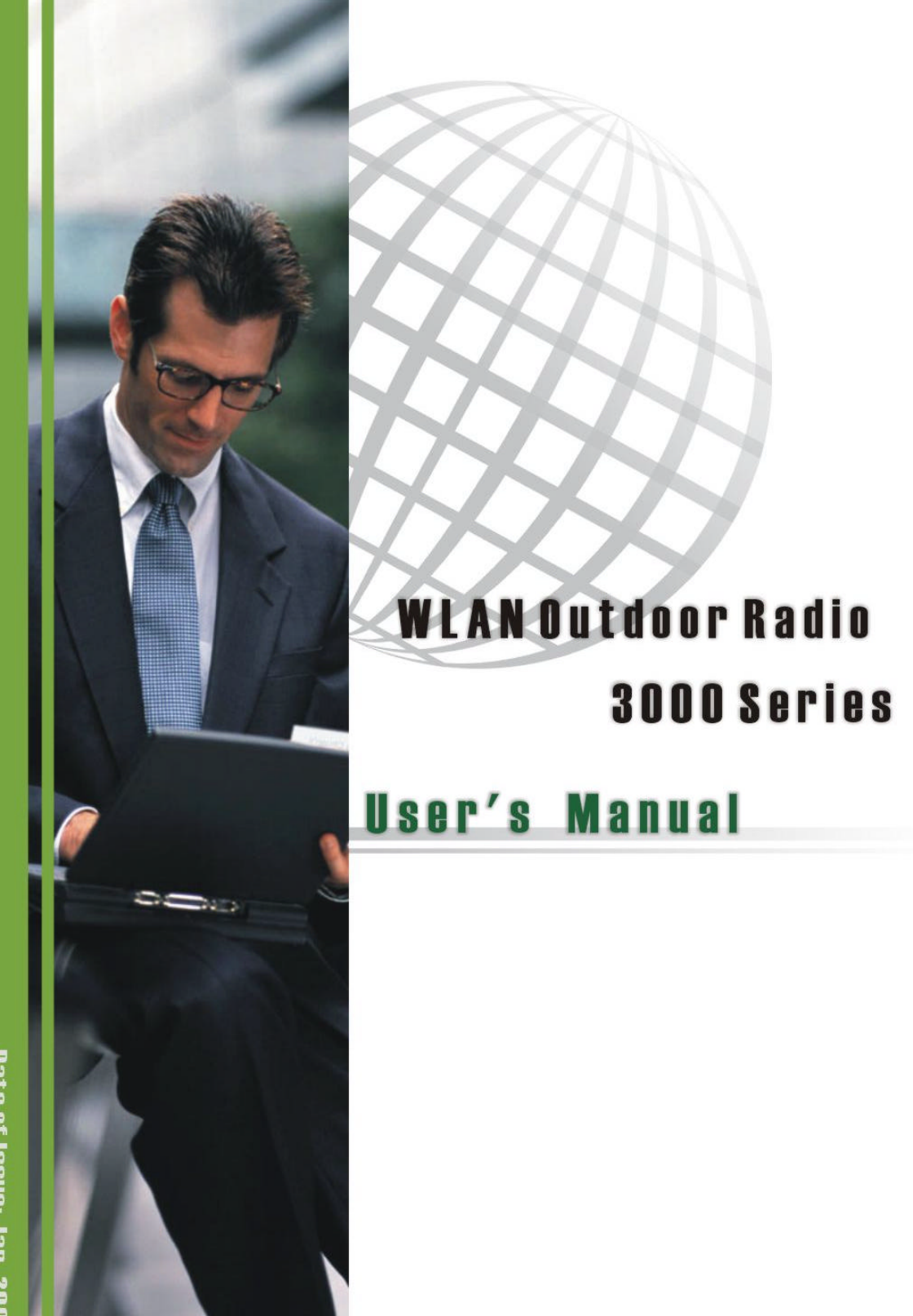
Copyright
Copyright © 2004 all rights reserved. No part of this publication may be reproduced,
adapted, stored in a retrieval system, translated into any language, or transmitted in any
form or by any means without the written permission of the supplier.
About This Manual
The purpose of this manual is for the setup of the 11Mbps Wireless LAN ODU. This
manual, revised as version 4.0.3 in 2004, includes procedures assisting you in avoiding
unforeseen problems.
Technical Support
If you have difficulty resolving the problem while installing or using the Wireless LAN
ODU, please contact the supplier for support.
FCC Certified Declaration:
This device complies with part 15 of the FCC rules. Operation is subject
to the following two conditions: (1) This device may not cause harmful
interference and (2) this device must accept any interference received,
including interference that may cause undesired operation.
Reminder:
To comply with FCC part 15 rules, the ODU must only be used as a
system as FCC certified. The system must also be professionally installed
to ensure compliance with the Part 15 certification. It is the responsibility
of the operator and professional installer to ensure that only certified
systems are deployed in where FCC rules apply. Further, according to
FCC Part 15 regulations, Section 15.247(b)(3)(iii), the installer must
ensure that the high-gain directional antenna used in this system is used
exclusively for fixed, point-to-point operations and that multiple
co-located intentional radiators transmitting the same information are
not used. For further information, please see Appendix B.
IMPORTANT NOTE:
To comply with the FCC RF exposure compliance requirements, no
change to the antenna or the device is permitted. Any change to the
antenna or the device could result in the device exceeding the RF
exposure requirements and void user’s authority to operate the device.
FCC Radiation Exposure Statement
This equipment complies with FCC radiation exposure limits set forth for an
uncontrolled environment when installed as directed. This equipment should
be installed and operated with fix-mounted antennas that are installed with
a minimum of 2 meters of separation distance between the antenna and all
persons’ body during normal operation.
Table of Contents
Chapter 1 Introduction..........................................................................5
1-1 Features and Benefits............................................................................. 5
1-2 Applications.......................................................................................... 6
1-3 System Configurations........................................................................... 7
Chapter 2 Hardware Installation.........................................................8
Chapter 2 Hardware Installation.........................................................9
2-1 Product Kit............................................................................................ 9
2-2 System Requirements ............................................................................. 9
2-3 Mechanical Description ....................................................................... 10
2-4 Hardware Installation.......................................................................... 11
Chapter 3 Configuring the ODU........................................................12
3-1 Configuration ...................................................................................... 12
3-2 Using the Web Management................................................................. 25
3-3 Using the Telnet................................................................................... 29
Appendix A: Channels................................................................................ 36
Appendix B: FCC Certified Systems ........................................................... 37
Appendix C: Troubleshooting....................................................................... 1

Chapter 1 Introduction
The Outdoor wireless LAN device – 11Mbps Wireless Outdoor Unit, are specially designed
for Point-to-Point applications, offering long distance connections between buildings at a
speed of up to 11Mbps. Fully compliant with IEEE802.11b standard, the Outdoor Unit
(ODU) provides powerful features such as the Windows-based configuration utility, MAC
address filtering, WEP security and more.
1-1 Features and Benefits
n Creates a Point-to-Point connection linking two LANs, using 2 Indoor Units or Indoor
and Outdoor total solutions.
n Integrated antenna allows you for easy installing the Outdoor bridge.
n With a data rate of 11Mbps and 5.5Mbps, the system is faster than an E1/T1 data link.
n Features 11Mbps data rate by incorporating Direct Sequence Spread Spectrum
technology.
n Fully IEEE 802.11b compatible. Allow inter-operation among multiple vendors.
n Technique operating in the unlicensed 2.4 GHz ISM band.
n Seamless roaming within the 802.11 & 802.11b wireless LAN infrastructure.
n Provides user authentication to enforce tight security.
n MAC address Access Control.
n Bandwidth control
n Advanced Security — 802.1x authentication (EAP)
n Provides Window-based configuration utility.
n Waterproof housing

1-2 Applications
The 11Mbps Wireless LAN ODU offers a fast, reliable, cost-effective solution for wireless
client access to the network in applications like these:
1. Remote Access to Corporate Network Information
E-mail, file transfer and terminal emulation.
2. Difficult-to-Wire Environments
Historical or old buildings, asbestos installations, and open area where wiring is difficult
to deploy.
3. Frequently Changing Environments
Retailers, manufacturers and those who frequently rearrange the workplace and change
location.
4. Temporary LANs for Special Projects or Peak Time
C1- Trade shows, exhibitions and construction sites where a temporary network will be
practical.
C2- Retailers, airline and shipping companies need additional workstations during peak
period.
C3- Auditors requiring workgroups at customer sites.
5. Access to Database for Mobile Workers
Doctors, nurses, retailers, accessing their database while being mobile in the hospital,
retail store or office campus.
6. High Security Connection
The secure wireless network can be installed quickly and provide flexibility. (Please
refer to page 17 for more information on encryption configuration.)
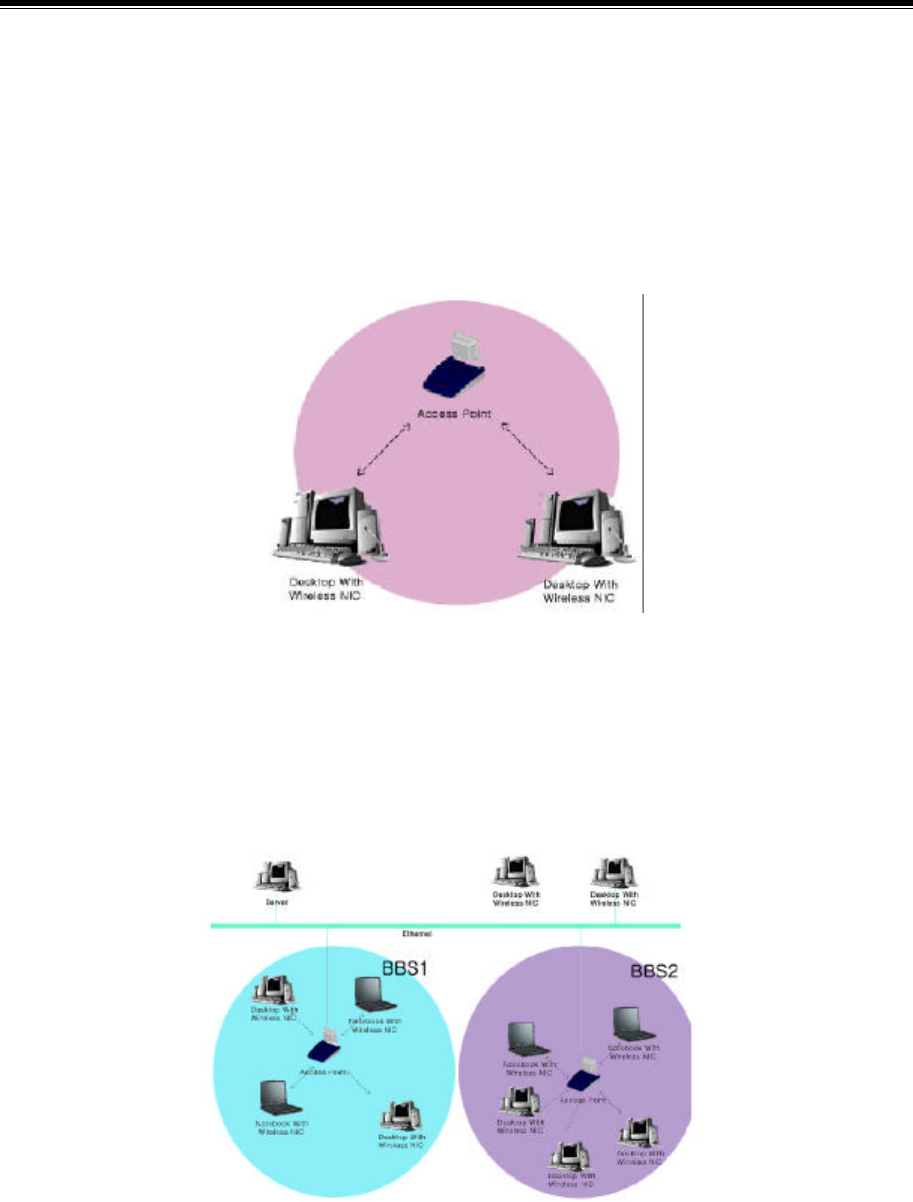
1-3 System Configurations
The 11Mbps Wireless LAN ODU can be configured in a variety of network system
configurations.
Wireless Infrastructure
In a wireless infrastructure, the ODU can act as a bridge. The ODU connects the wireless
clients together. The ODU acts as a center point for all wireless communications. This
would increase efficiency of the communications since the wireless adapters do not need to be
within direct range of each other.
Wireless Infrastructure with Stations Attaching to a Wired LAN
The 11Mbps Wireless LAN ODU will provide an access to the local LAN. An integration of
wireless and wired LAN is called an Infrastructure configuration. A group of wireless LAN
PC users and an ODU construct a Basic Service Set (BSS). Each wireless PC in this BSS
can talk to each other on your network via the ODU.
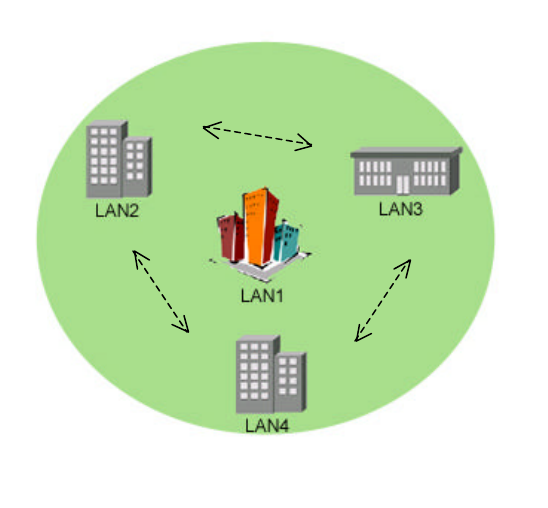
Point-to-Point
The 11Mbps Wireless ODU provides ideal bridging solution for inter-building LANs
connection. In an inter-building application, the 11Mbps ODU acts as a repeater, thus
expanding and connecting corporate LANs with reliable and high speed connection.

Chapter 2 Hardware Installation
This chapter describes initial setup of the Wireless LAN ODU subsystem.
2-1 Product Kit
Before installation, make sure that you the following items:
u 11Mbps Wireless LAN ODU Kit………… ..…………… .……..x 1
u Power over Ethernet………………………………….…………x 1
u Power Adapter……………………………….…….……………x 1
u Power Cord………………………………………………………x 1
u Mounting kit..……………………………….…………………...x 1
u Product CD………………………………………………………x 1
u Quick Installation Guide……………………………….……….x 1
NOTE: If any of the above items are missing or damaged, please contact your local dealer for
support.
2-2 System Requirements
Installation of the 11Mbps Wireless LAN ODU requires:
1. A DC 12V adapter which supplies the power for the PoE (Power over Ethernet).
2. A 10/100 Base-T (UTP) Ethernet cable drop.
3. Operating system support: Windows 98/Me/NT4.0(SP4 or above)/2000/XP
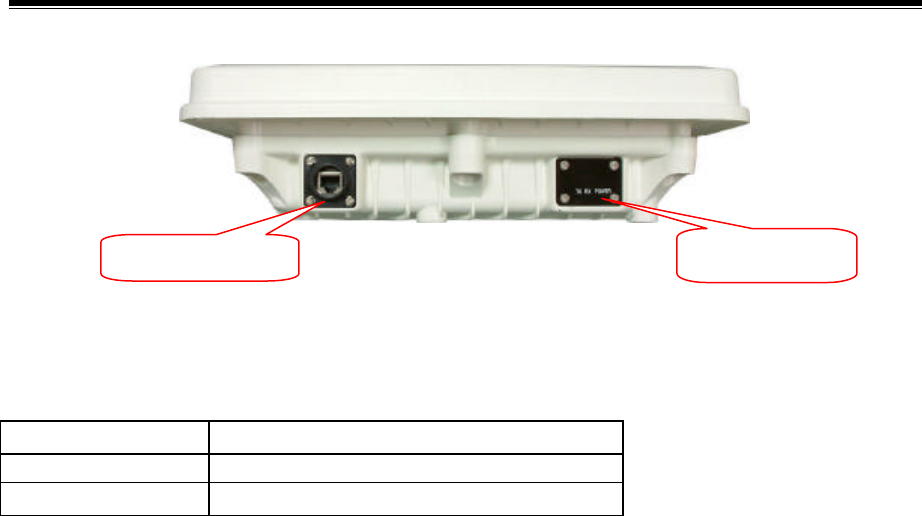
2-3 Mechanical Description
ODU:
LED Indicator
Product type LED Indicator
2.4GHz 0.1W Power
2.4GHz 0.5W/1W Power、Tx、Rx
Waterproof RJ-45 connector
Connect to the POE with SFTP cable.
SFTP Cable
This cable is attached to the ODU. The default SFTP cable length is 25 meter.
LED Indicator
RJ-45(To POE)
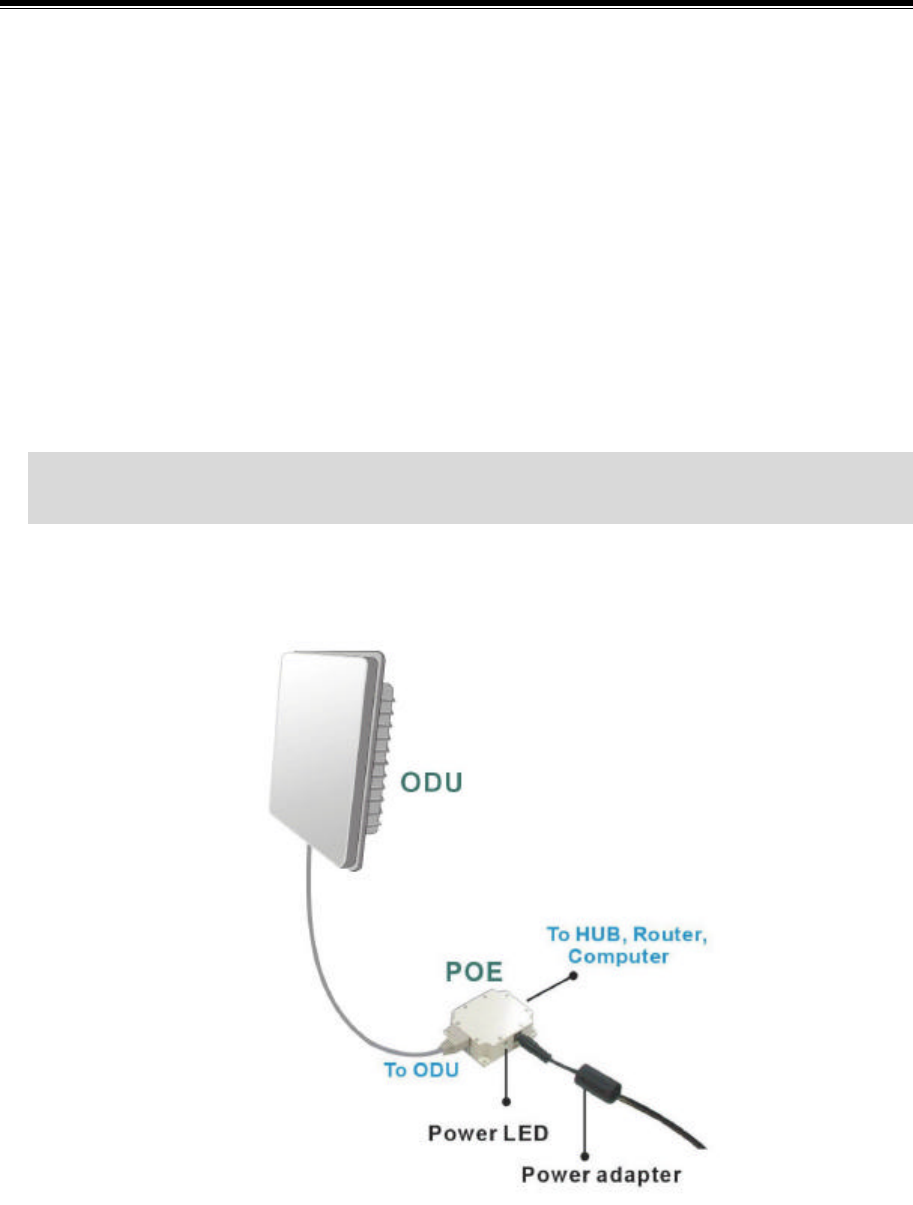
2-4 Hardware Installation
Take the following steps to set up your ODU.
n Connect the Ethernet Cable
The 11Mbps Wireless LAN ODU supports 10/100M Ethernet connection. Connect the
SFTP cable from the ODU to the RJ-45 connector of PoE (marked “To ODU”) for ODU
connection. Then connect the other end of the POE with straight RJ-45 cable to a hub or a
switch. Please note that, use the cross-over cable when you desire to connect the PoE
of ODU to a PC.
n Connect the Power Cable
Connect DC 12V adapter to the PoE, and plug the other end of the adapter into an
electrical outlet.
NOTE: Only use the power adapter supplied with the PoE of ODU. Otherwise, the product
may be damaged.

Chapter 3 Configuring the ODU
The 11Mbps Wireless LAN ODU is shipped with default parameters, which will be suitable
for the typical Point-to-Point. You can still adjust configuration settings depending on how
you would like to manage your wireless network. The 11Mbps Wireless ODU allows for
configuration either via the configuration utility, known as Access Point Manager, TCP/IP
(Telnet) connection or Web Management.
3-1 Configuration
Installed on your Windows 95/98/NT/ME/2000/XP desktop computer, the Windows-based
utility “Access Point Utility” provides a user-friendly interface. The ODU Utility enables
you to configure all of your ODUs on the network more easily than ever before. The
following gives instructions guiding you through the installations of the ODU Utility.
1. Insert the Product CD-ROM disk that came with your product kit into the corresponding
drive on your computer.
2. From the Start menu on the Windows desktop, choose Run.
3. In the Run dialog box, type the path where the utility is located, then click OK.
4. Follow the on-screen instructions to install the Access Point Utility.
5. Upon completion, go to Program Files and execute the Access Point Utility. It will begin
to browse all the ODU available on the network.
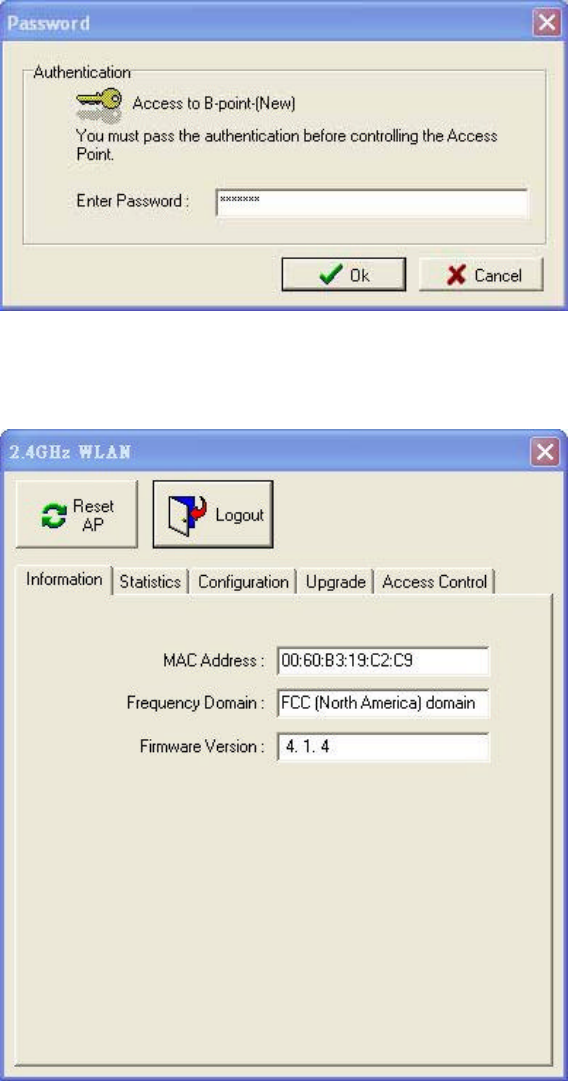
6. Double click Access Point icon to access its property dialog box. Enter the password in
the entry field. The default password is “default”.
7. After entering the correct password, a configuration window appears. You will see the
basic information of the ODU, such as MAC Address, Frequency Domain and Firmware
Version.
MAC Address: It is a hardware identification number that distinguishes the unit from others.
Frequency Domain: The regulated operating frequency per country.
Firmware Version: Displays the firmware version that is equipped with your hardware.
Statistics
The statistics tab contains three of the following items for you to monitor the Ethernet and
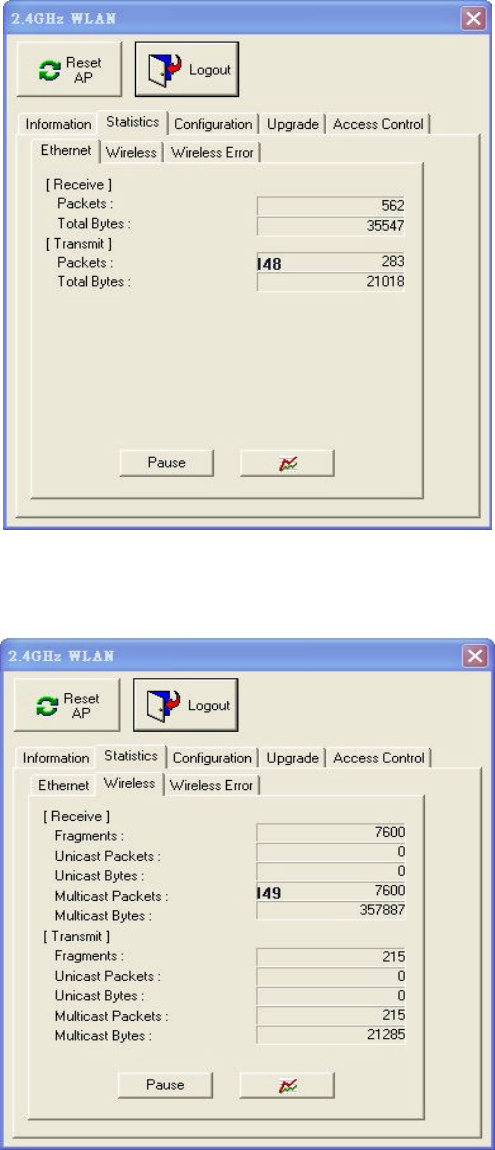
Wireless network traffic.
Ethernet:
You may monitor the TX/RX on the wired network.
Wireless:
You may monitor the TX/RX of the wireless network.
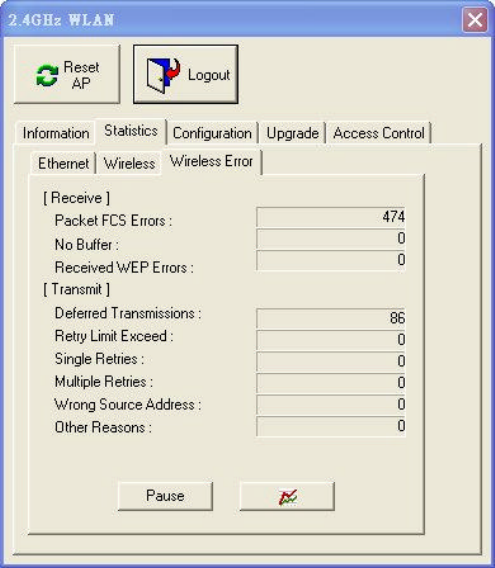
Wireless Error:
This item offers detailed information on error wireless packets that the ODU receives and
transmits.
Receive:
Packet FCS Errors: The number of wireless packets that fail during FCS transmission (Frame
Check Status when accessing the wired network.
No Buffer: The number of wireless packets that the ODU ignores due to insufficient memory.
Received WEP Errors: The number of wireless packets that have WEP encryption errors.
Transmit:
Deferred Transmission: The number of packets that have deferred transmission due to the fact
that the medium is busy.
Retry Limit Exceed: The number of packets that are not sent due to the reason that the packets
exceed the retry limits.
Single Tries: The number of packets that are successfully sent on the first retry.
Multiple Retries: The number of packets that are successfully sent after several retries.
Wrong Source Address: The number of packets that are ignored by the ODU because the
source client is not in its BSS.
Other reasons: Other reasons that cause errors.
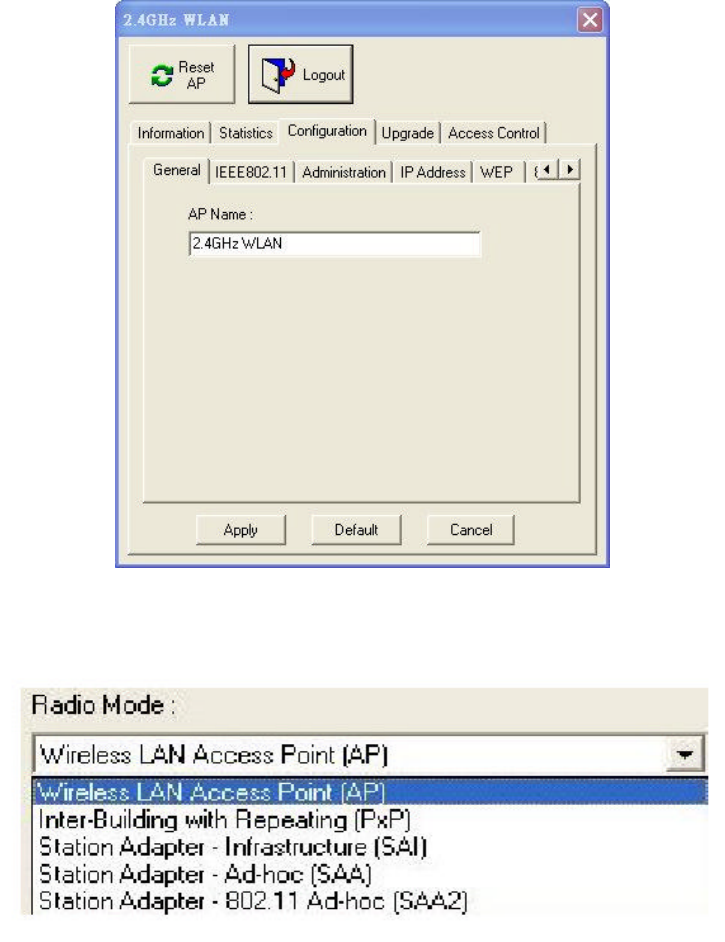
Configuration
The configuration tab contains 5 following items for you to make changes for the ODU.
General:
AP name: In this entry field, you may enter any name. This will enable you to manage your
ODU with more ease if you have multiple ODU on the network.
IEEE802.11:
Radio Mode: The Wireless LAN ODU can operate total of 5 radio modes:
Ø Wireless LAN Access Point (AP): Enables the ODU to act as a wireless bridge
connecting to your network backbone.
Ø Inter-building with Repeating (PxP): Allows for multi-point connection among LANs
(default setting).
Ø Station Adapter – Infrastructure (SAI): Served as a wireless station (infrastructure).
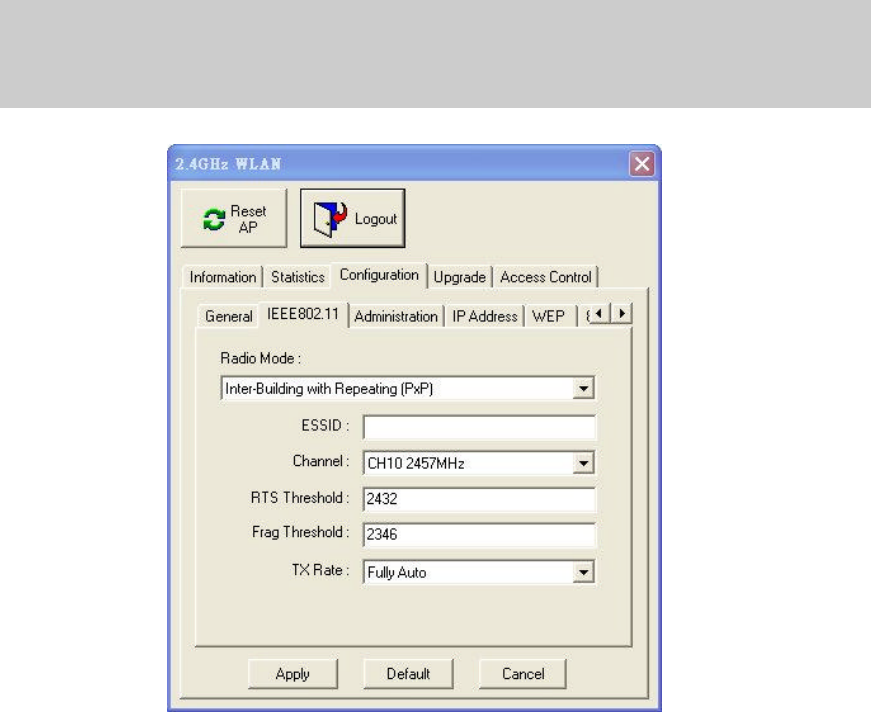
Connect the ODU (SAI) to a PC with a cross over RJ-45 cable, and it is able to access
the network via ODU.
Ø Station Adapter – Ad-Hoc (SAA): Served as a wireless station (Ad-hoc). Connecting to
a PC with a cross-over RJ-45 cable, the station adapter along with other wireless stations
can establish a small wireless network without ODUs.
Ø Station Adapter – 802.11 Ad-Hoc (SAA2): Similar to SAA, the ODU acts as a wireless
stations (Ad-Hoc). The only difference is that this Ad-Hoc mode complies with 802.11
standard.
NOTE: When setting the operation mode to either PxP or SAA, you need to set the ODU
with the same channel. ESSID however can be ignored. When the SAA2 is selected,
you need to set the ODU the same ESSID and channel.
ESSID: The ESSID is a unique ID given to the ODU. Wireless clients associating to the
ODU must have the same ESSID. The ESSID can have up to 32 characters.
Channel: You may select any of the available channels as an operational channel for your
ODU. You may use the Site Survey tool came with the wireless PC Card utility to monitor
each channel and choose a channel with good quality.
RTS Threshold: RTS Threshold is a mechanism implemented to prevent the “Hidden
Node” problem. “Hidden Node” is a situation in which two stations are within range of the
same ODU, but are not within range of each other. Therefore, they are hidden nodes for
each other. When a hidden station starts data transmission with the ODU, it might not notice
that another station is already using the wireless medium. When these two stations send data
at the same time, they might collide when arriving simultaneously at the ODU. The collision
will most certainly result in a loss of messages for both stations. Thus, the RTS Threshold
mechanism will provide the solution to prevent data collisions. When the RTS is activated,
the station and its ODU will use a Request to Send/Clear to Send protocol (RTS/CTS). The
station will send an RTS to the ODU, informing that it is going to transmit the data. Upon
receipt, the ODU will respond with a CTS message to all station within its range to notify all
other stations to defer transmission. It will also confirm to the requesting station that the ODU
has reserved the channel for transmission.
Fragmentation Threshold: Fragmentation mechanism is used for improving the efficiency
when there is high traffic within the wireless network. If you transmit large files in a
wireless network, you can enable the Fragmentation Threshold and specify the packet size.
The mechanism will split the packet into the packet size you set.
TX Rate: When the ODU is under PXP, SAI, SAA, and SAA2, it provides various data rate
options for you to select. Data rates options include Fully Auto, Fixed 1Mb/s, Fixed 2Mb/s,
Auto Select 1M or 2M, Fixed 5.5Mb/s, and Fixed 11Mb/s. In most networking scenarios,
you will see that the factory-set default “Fully Auto” will prove the most efficient. This
setting will allow your 11Mbps Wireless LAN ODU to operate at the maximum data rate as
possible. When the communications quality drops below a certain level, the ODU will
automatically switch to a lower data rate. Transmission at lower data speeds is usually more
reliable. However, when the communications quality improves again, the 11Mbps Wireless
LAN ODU will gradually increase the data rate again, until it has reached the highest
available transmit rate.
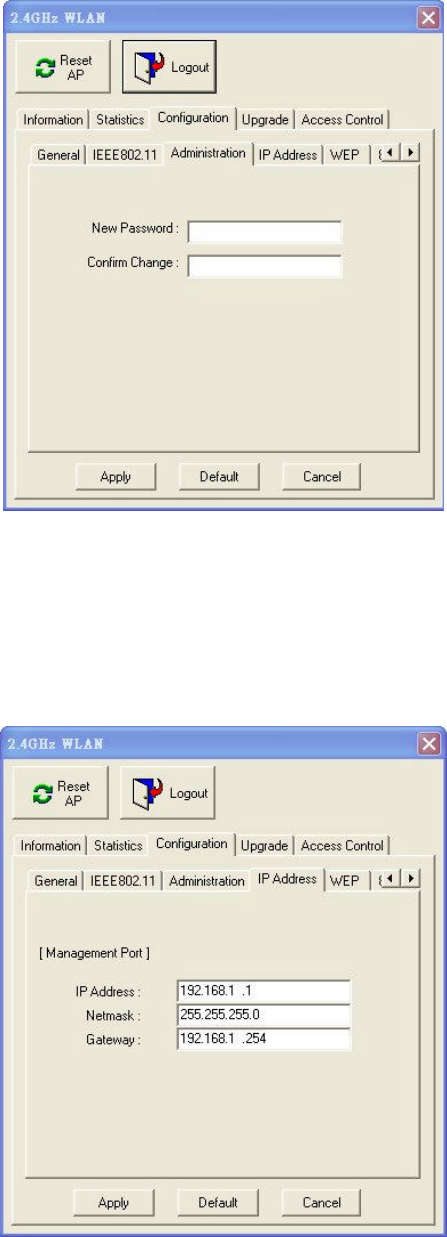
Administration:
You may change the default password by entering the new password. Enter the new
password in the Confirm Change field to make the new setting take affect.
IP Address:
To enable remote access to the ODU using Telnet or Web Management, you must assign an IP
address to the ODU. You may also assign other related Internet addressing options, such as
subnet mask or gateway address. Consult your network administrator to obtain an available
IP address. (Default setting is 192.168.1.1)
WEP:
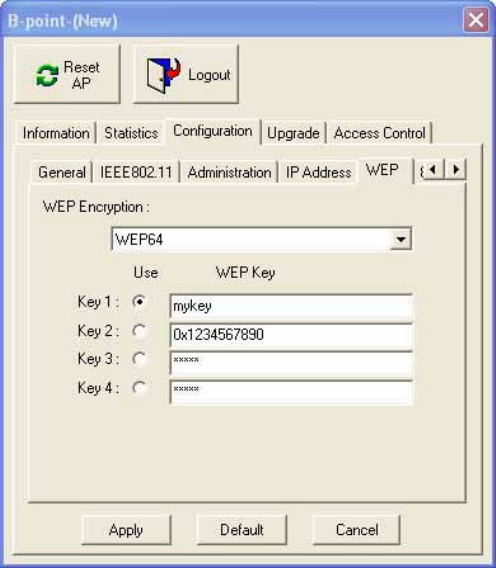
If data transmission with high security is required on your network, it is recommended that
the WEP encryption be used. To activate the WEP encryption, select Configuration, go to the
WEP tab, and do the following:
Pull down the WEP Encryption menu and select WEP64 or WEP128.
You may identify up to 4 different encryption keys and select one of them to encrypt your
transmission data. The key value of your choice may either be:
From the 4 Key entry field, enter the corresponding key value for each encryption method.
For WEP64 data encryption:
-- 5 alphanumeric characters in the range of “a-z”, “A-Z” and “0-9” (e.g. MyKey).
-- 10 digit hexadecimal values in the range of “A-F” , “a-f” and “0-9”, preceded by the
characters “0x” values (e.g. 0x11AA22BB33).
For WEP128 data encryption:
-- 13 alphanumeric characters in the range of “a-z”, “A-Z” and “0-9” (e.g. MyKey12345678).
-- 26 digit hexadecimal values in the range of “A-F” , “a-f” and “0-9”, preceded by the
characters “0x” values (e.g. 0x00112233445566778899AABBCC).
WEP64 Key Setting
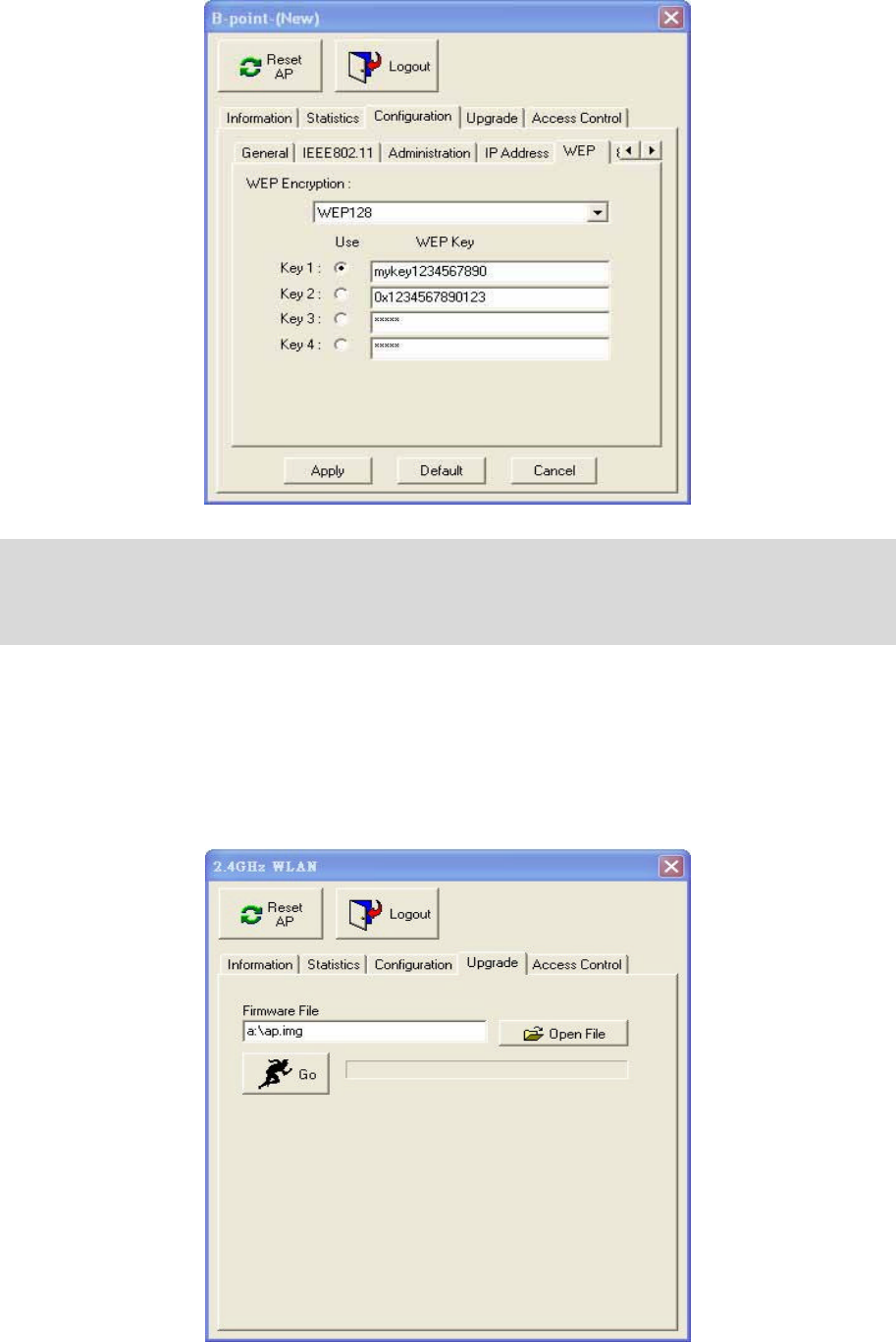
WEP128 Key Setting
NOTE: The WEP key must be set up exactly the same on the ODU as they are on other
wireless client stations. For example, if you set “MyKey” for the ODU, the same WEP Key
“MyKey” must be assigned to other client stations.
Upgrade
This item is used for uploading the newest firmware of the ODU. You may either enter the
file name in the entry field or browse the file by clicking the Open File button. For
information about the release of the newest firmware, contact your local reseller.
Access Control:
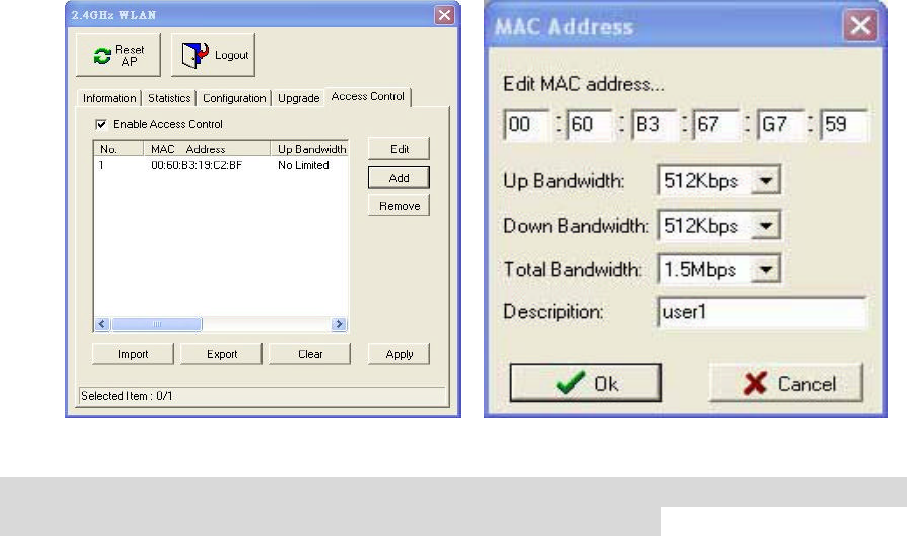
With the Access Control enabled, you can authorize wireless units to access the Access Point
by identifying the MAC address of the wireless devices that are allowed access to transmit
data. Further more, the Bandwidth control function allows you to control the
upstream/downstream bandwidth per client basis. Note that, only when the MAC addresses of
the wireless stations are in the Access Control Table, they will be able to access network via
Access Point. To create or edit the Access Control Table, do the following:
Ø Go to the Access Control tab and check “Enable Access Control”.
Ø Click the “Add” button and enter the MAC addresses of the wireless stations you allow
to access.
Ø Set “Up bandwidth”, “Down bandwidth” and “Total bandwidth” if needed. Specify the
desired bandwidth or unlimited if you do not need the bandwidth control.
Ø Click “Apply” to make the setting take effect.
You can also configure the Access Control by using web-based management.
NOTE: Be aware that, when you enable the Access Control Table without any MAC address
in the table, no access is allowed to communicate with the Access Point.
Use the following buttons to manage the Access Control Table:
Add – to enter MAC addresses of authorized wireless devices one at a time.
Edit – to change the entries in the table if you enter the incorrect MAC address.
Remove – to remove MAC addresses one at a time.
Clear – to remove all MAC addresses in the table.
Import – to import an existing Access Control Table.
Export – to save the current Access Control Table to a location on your computer. You may
save the file as a text document.
Advanced Security
The 802.1x authentication (EAP) is designed to enhance the security of wireless networks.
The 802.1x provides an authentication framework for wireless LANs, allowing a user to be
authenticated by a central authority. For wireless LANs, it also provides centralized,
server-based authentication of end users. The standard is flexible enough to allow multiple
authentication algorithms, and because it is an open standard, multiple vendors can innovate
and offer enhancements.
For wireless LANs, the 802.1x authentication has three main components: The supplicant
(usually the client software, such as zero configuration in window XP), the authenticator
(usually the access point), and the authentication server (usually a Remote Authentication
Dial-In User Service server, although RADIUS although 802.1X does not specify it).
The advanced security describes how to control authorized access to the Access Point with
Authentication Dial-In User Service (RADIUS). There are many ways to enhance your
wireless security: 802.1x Based Auth mode or MAC Address Based Auth mode. To enable
802.1x based authentication, please select 802.1x Based Auth mode. Moreover, you may
enable the radius account function by check Enable Radius Account in the check box. To
configure the Authentication and Account Server function, the parameter of Radius
Authentication Server and Radius Account Server must set to the same with the
Authentication Server and Account Server. Before you enable RADIUS account, you have
select 802.1x Based Auth mode first.
Note: The Password is up to 16 bytes.
If you want to use MAC Address Based authentication, you should select MAC Address
Based Auth mode. However, the RADIUS account server will not be supported here.
Most likely, the MAC Address Based authentication is less secure than 802.1x (EAP)
authentication. MAC Address Based authentication provides an alternative for wireless 10
network security that does not support 802.1x capability.
Otherwise, you may select disable auth mode that adjusts to the 802.11 legacy network. For
setting 802.1x Based Auth:
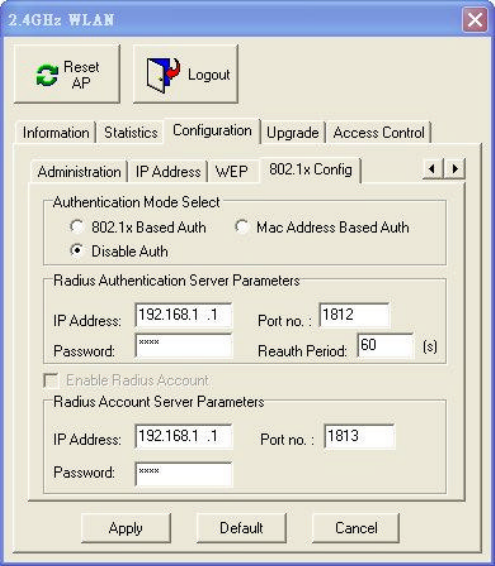
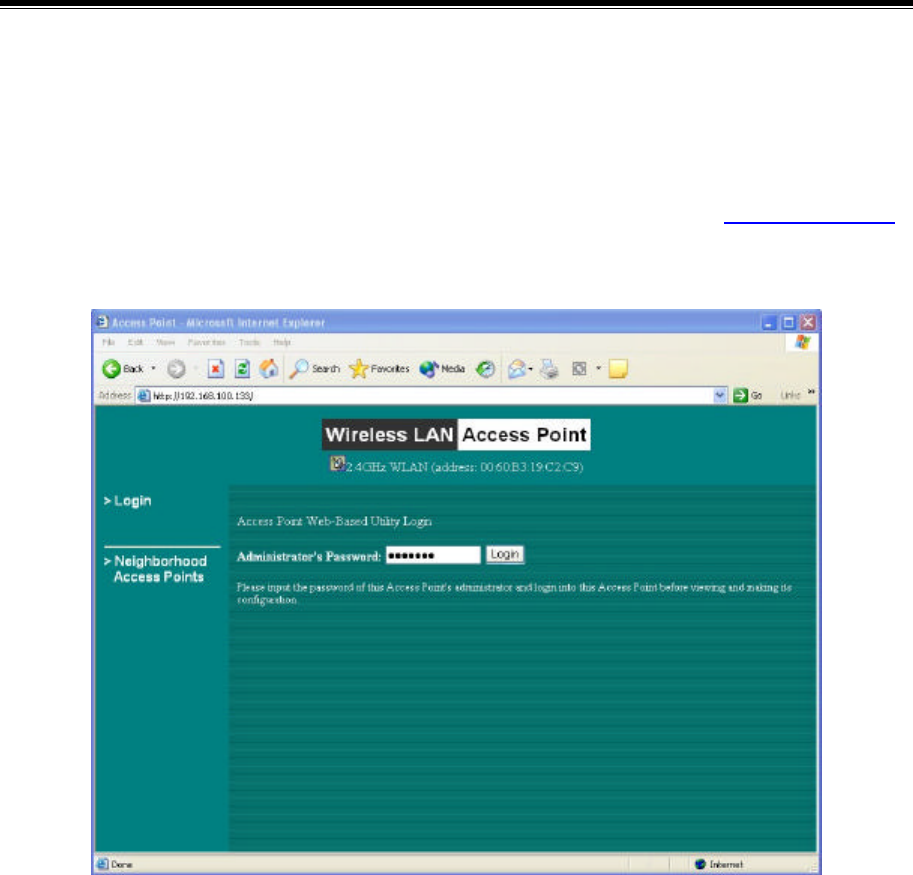
3-2 Using the Web Management
The built-in Web Management provides you with a user-friendly graphical user interface (web
pages) to manage your ODU. An ODU with an assigned IP address (e.g. http://192.168.1.1)
will allow you to monitor and configure the ODU.
1. Open your web browser.
2. Enter the available IP address of your ODU in the Address field (e.g. http://192.168.1.1).
You will have access to the Wireless LAN Access Point Web Pages of the ODU.
3. Enter the password to login to the ODU. The default password is default. The main
page will show up. The ODU main page contains three items for you to manage your
ODU.
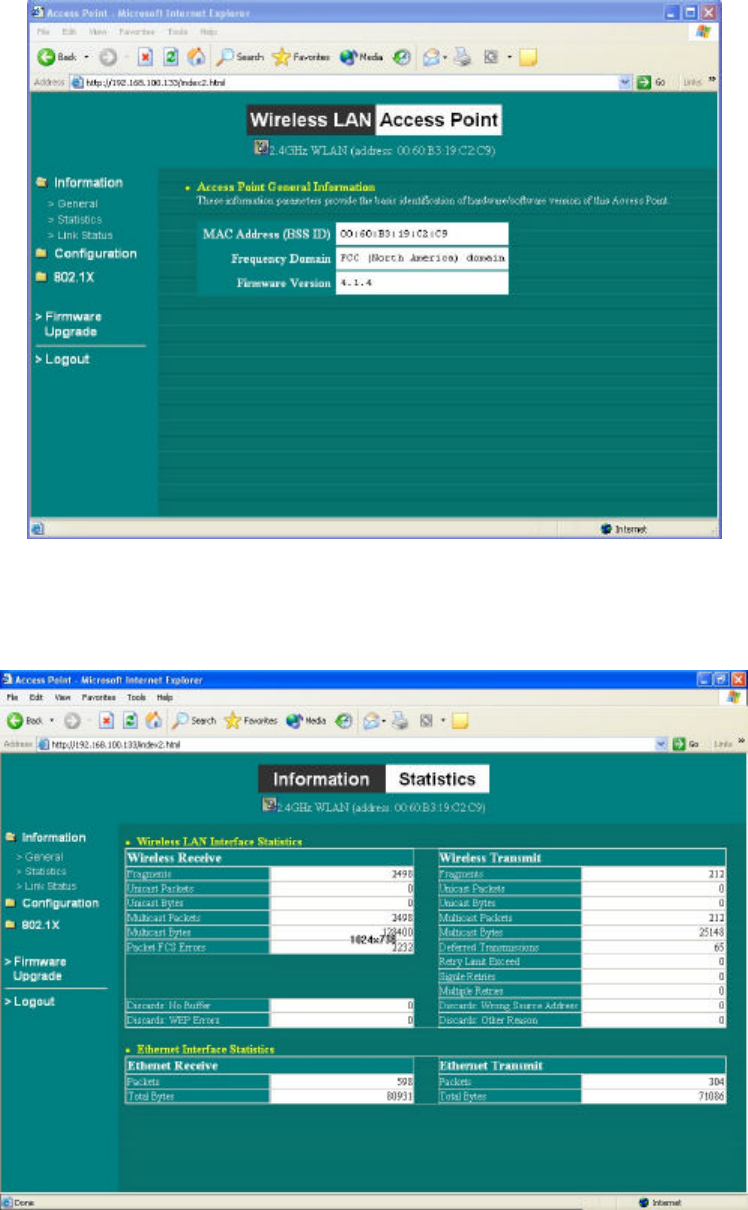
Information
General
This item displays the general information of the ODU such as the MAC address, Frequency
Domain, and Firmware Version.
Statistics
This item displays the Ethernet and wireless network traffic.
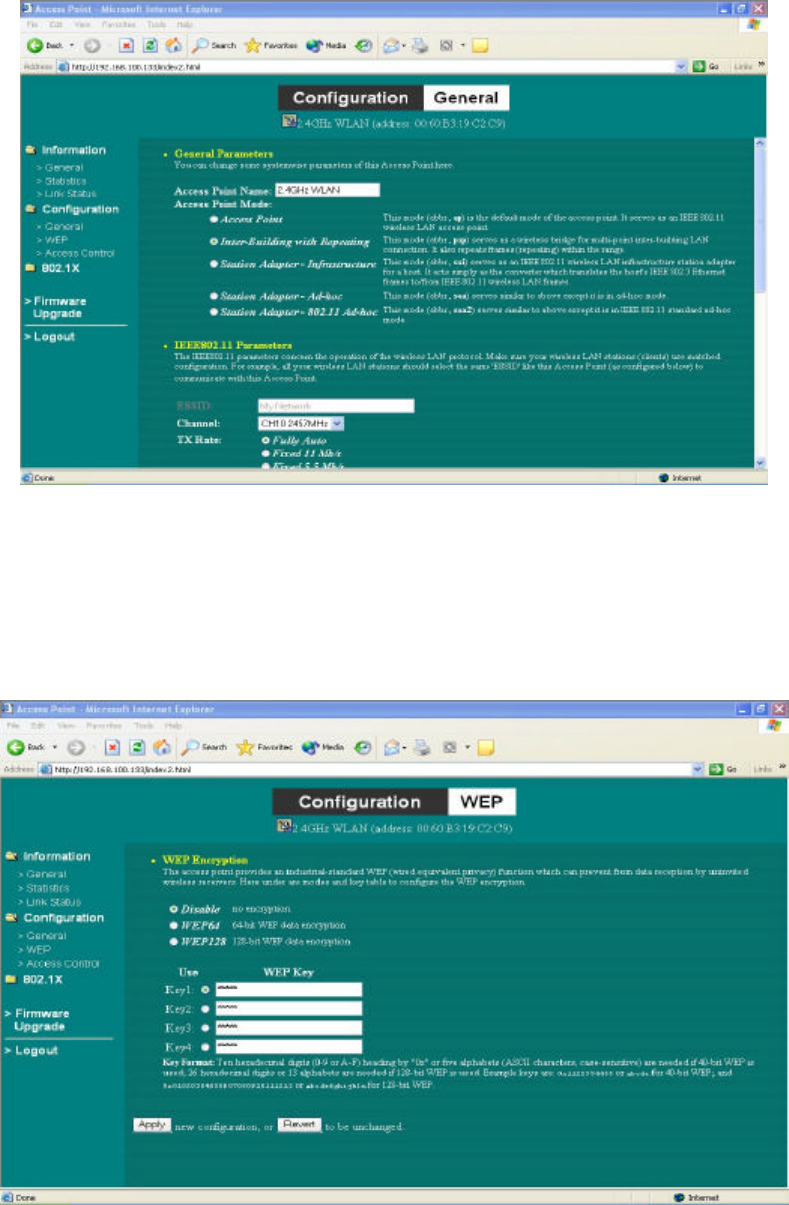
Configuration
General
You may make the settings on the ODU such as AP Name, AP Mode, ESSID, Channel, RTS
Threshold, Fragment Threshold, TX Rate and Password.
WEP
To prevent unauthorized wireless stations from accessing data transmitted over the network,
the 11Mbps Wireless LAN ODU offers WEP (Wired Equivalency Privacy). You can set up
4 encryption keys but choose one key to encrypt your data.
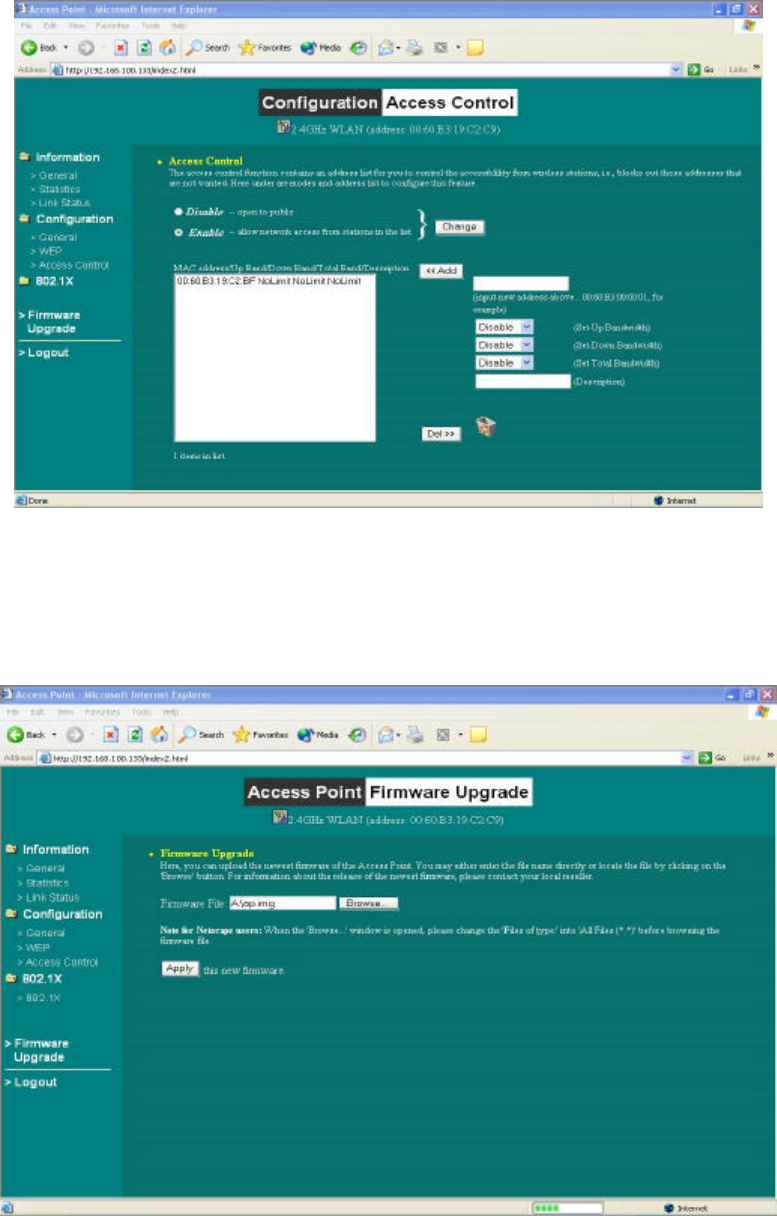
Access Control
The Access Control Table enables you to restrict wireless stations accessing the ODUs by
identifying the MAC address of the wireless devices.
Upgrade
Here, you can upload the newest firmware of the ODU. You may either enter the file name
in the entry field or browse the file by clicking the Browse button.
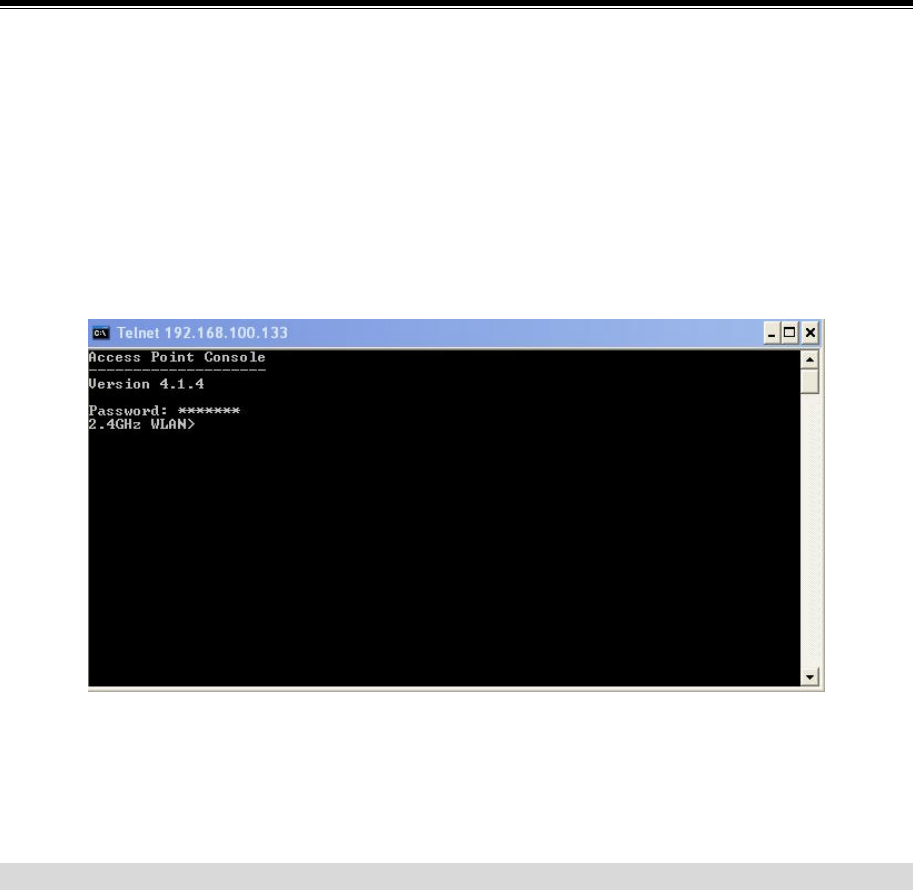
3-3 Using the Telnet
The ODU can be configured via the command prompt console with TCP/IP:
Telnet (TCP/IP) Connection: Assign an available IP address to your ODU through the RS232
connection or Access Point Utility and then telnet into the ODU anywhere to get access to the
ODU console. Thus, you will be able to make the configuration via the TCP/IP connection.
1. Telnet to your ODU. A window will show up.
2. Enter the password. The default password is “default”.
3-3-1 Basic Commands
The following are the commands provided for configuring the ODU. In loader mode, i.e., no
valid firmware in the ODU, only the commands with an asterisk (*) are provided.
NOTE: [xxx] stands for optional arguments.
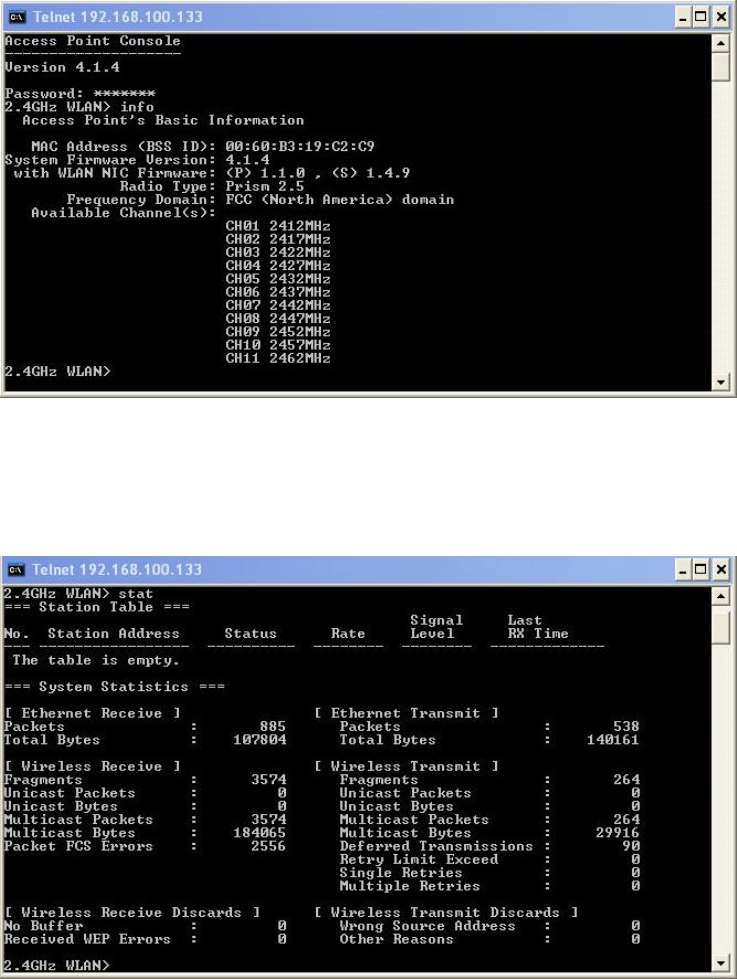
info*
Display some basic information of the ODU, for example, firmware version, frequency
domain, etc.
stat
Display the statistical values of the operation of the ODU, for example, association status,
LAN/WLAN interface load, etc.
ping ip_addr [num_pings] [data_size]
Ping (ICMP echo) to an ip_addr host with optional num_pings times with optional data size
in a length of data_size.
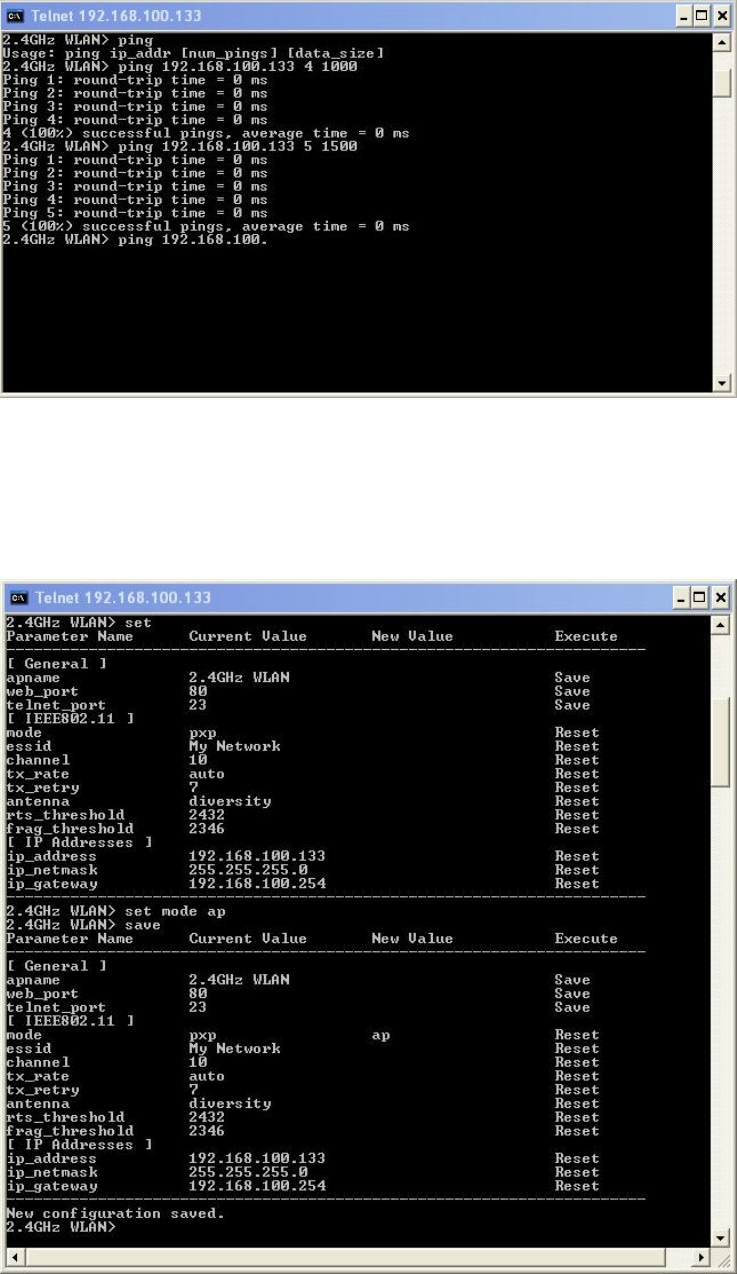
set List the configuration information.
set apname | web_port | telnet_port | mode | channel | essid | tx_rate | tx_retry | antenna|
rts_threshold | frag_threshold | ip_address | ip_netmask | ip_gateway
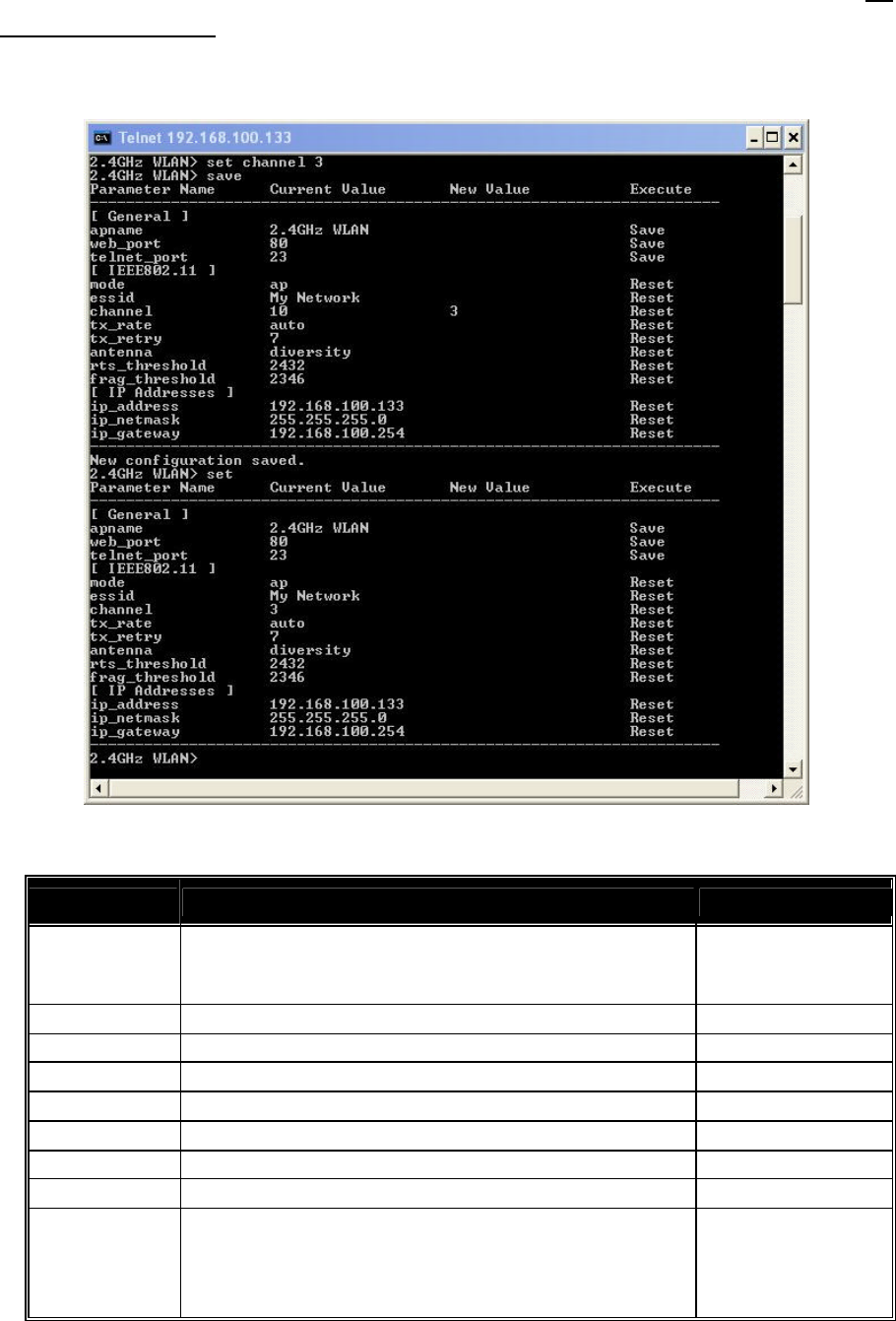
To change factory default settings, type “set xxx (parameter) xxxx (value). For example, set
essid “Your Network” command will set the ESSID as Your Network. Remember that, a
'save' command is required for changes to take effect. Always reset your ODU with the
“reset” command.
The following is a list of parameters you can make changes on the ODU.
Parameter Description Default Value
apname A textual name for the identification of the ODU. apXXXXXX
(where XXXXXX is the last
six octets of ODU’s MAC
address)
web_port Port number dedicated to WEB 80
telnet_port Port number dedicated to Telnet 23
mode Operation mode of the ODU PxP
channel The radio channel number. 1
essid The ESS ID (a.k.a., SSID) of the ODU. My Network
tx_rate Transmission Rate Auto
tx_retry Number of retries for data transmission 7
rts_threshold The threshold (number of bytes) for enabling
RTS/CTS handshake. Data with its frame size
larger than this value will perform the RTS/CTS
handshake. Range of value: 0~2432.
2432

frag_threshold
The threshold (number of bytes) for the
fragmentation boundary. Data will be transmitted
in fragments which its size does not exceed this
value. Range of value: 256~2432.
2432
ip_address The IP address of the ODU. 192.168.1.1
ip_netmask The subnet mask address of the ODU. 255.255.255.0
ip_gateway The default gateway address of the ODU. 192.168.1.254
save
Save your new configuration. Remember that the “save” command is required every
time you make the new configuration.
set default
Return the factory default settings of the ODU except for the IP addresses. A 'save'
command is required for changes to take effect.
cls*
Clear the console screen.
exit*
Exit the console.
? * or help*
Print a help screen.
reset*
Issue a reset signal. The ODU will be reset if user confirms.
3-3-2 Advanced Settings for Security
This section describes the commands to control the security for ODU. To prevent
unauthorized wireless stations from accessing data transmitted over the network, the 11Mbps
Wireless LAN ODU offers the following levels of security options.
- Access Control Table restricts wireless stations to access the ODU.
- Data Encryption, known as WEP (Wired Equivalency Privacy), encrypts wireless data
transmitted via wireless medium.
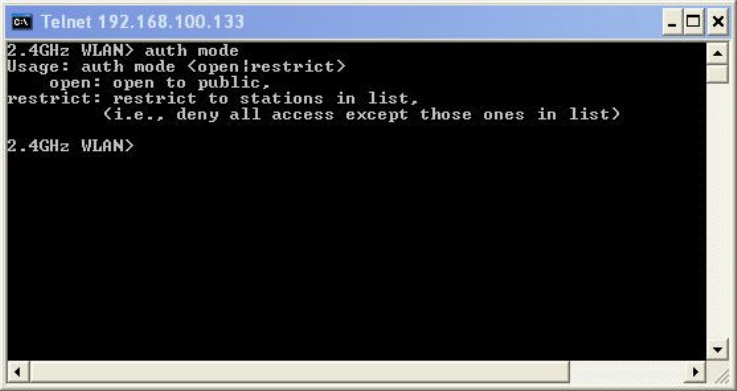
Access Control
auth mode | add | del | list| clear
The 'auth' command contains sub-commands that allow you to manage the access control
(MAC address filter) of the ODU. The access control table consists of a list for you to
control the accessibility of any wireless stations or repeaters. The sub-commands are
listed below:
mode open | allow: set the access control mode. The definition of each mode is specified
as follows:
• open: open to public (default)
• restrict: only allow access of the authorized stations/repeaters in the table (no
access is allowed if the list stays empty)
add mac_addr: add an address into the access control table
del mac_addr |index: delete a MAC address, or index an address from the access control
table
list [start/end]: display the content of the access control mode and the address list. The
optional arguments, start and end, can be affixed to select the range of items
to be listed.
clear: clear all the addresses in the access control table.
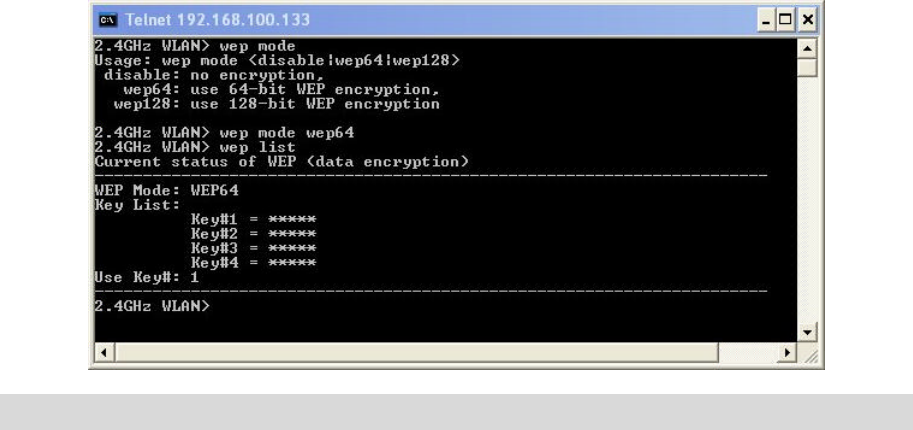
WEP Keys
wep mode | set | list
The 'wep' command contains sub-commands that allow you to manage the data encryption
(WEP, wired equivalent privacy) function provided with the ODU. The sub-commands are
listed as follows:
mode disable | wep64: set the access control mode. The following are the definition of
each data encryption mode.
• none: no encryption (default)
• wep64: use 64-bit WEP data encryption
• wep128: use 128-bit WEP data encryption
set key1 key_text: set WEP Key#1 as key_text. 10 hexadecimal digits (0-9 or A-F)
heading by “0x” or five alphanumeric values (ASCII characters,
case-sensitive) are required if 64-bit WEP is used.
Example: 0x1122334455, 0x0055AA55AA, abcde, or MyKey.
set key2 key_text: set WEP Key#2 as key_text with a same format as WEP Key#1.
set key3 key_text: set WEP Key#3 as key_text with a same format as WEP Key#1.
set key4 key_text: set WEP Key#2 as key_text with a same format as WEP Key#1.
set usekey 1|2|3|4: Select the WEP key to be used for encrypting data transmission. Only
one key can be selected at a time.
list: Display current WEP settings.
Note: Your new WEP settings will take effect after resetting the ODU.

Appendix A: Channels
Conversion Table
802.11b Channel Frequency(MHz)
1 2412
2 2417
3 2422
4 2427
5 2432
6 2437
7 2442
8 2447
9 2452
10 2457
11 2462

Appendix B: FCC Certified Systems
FCC ID#: QZGBL3006F-001
FCC Certified Systems consist of:
Ø BL3006F WLAN ODU,PoE,Power Adapter,Power Cord,SFTP Cable
Ø Outdoor Antenna
Ø UTP RJ-45 Cable
The WLAN ODU has passed the FCC regulations:
FCC part 15, subpart C(2002)
Authorized Antennas
Model Antenna Type
Antenna Gain(dBi) Max EIRP(dBm)
KBNT2418-16
Flat Panel 18 Peak output need only
be reduced by 1 dB for
every 3dB of antenna
gain above 6dBi
Note: Cable calculation must be performed using 2.4GHz attenuation values
because all signals pass between the ODUs are at a frequency of 2.4GHz.

-1
-
Appendix C: Troubleshooting
If there is no signal output, please check the following item:
1. Check whether the LED indicator on the PoE and ODU is on. If not, it means there is
problem with the power component.
(1) Check if the power cord is correctly connected with the power adapter and the power
outlet.
(2) Check if there is electricity on power outlet.
2. Check if the connection between antenna and WLAN ODU is correct, or whether the
connector is loose or not.
3. Check if the connection between WLAN ODU and PoE is correct, or whether the
connector is loose or not.
4. Verify if the transmit power which calculated before is correct.
5. If none of the above measures could solve troubleshooting, please contact the supplier for
further support.